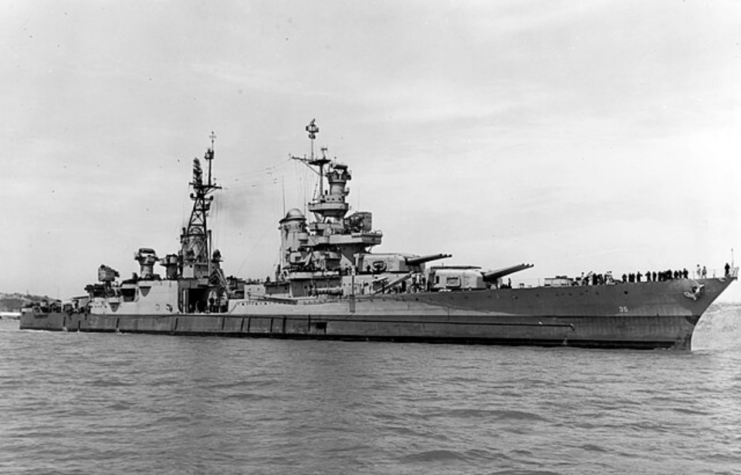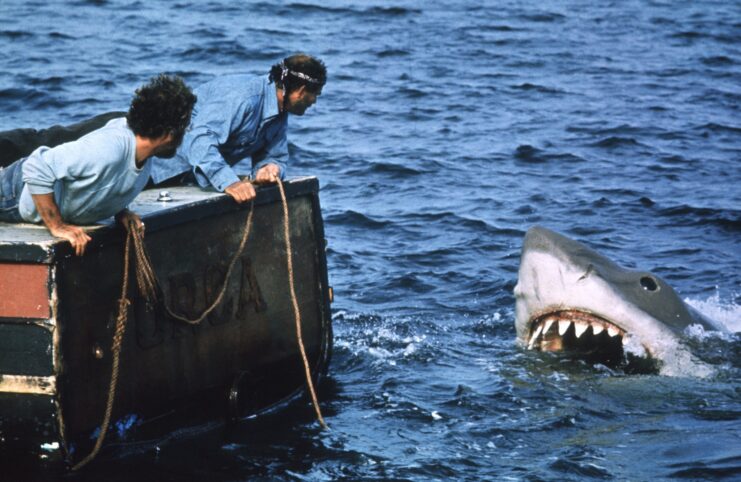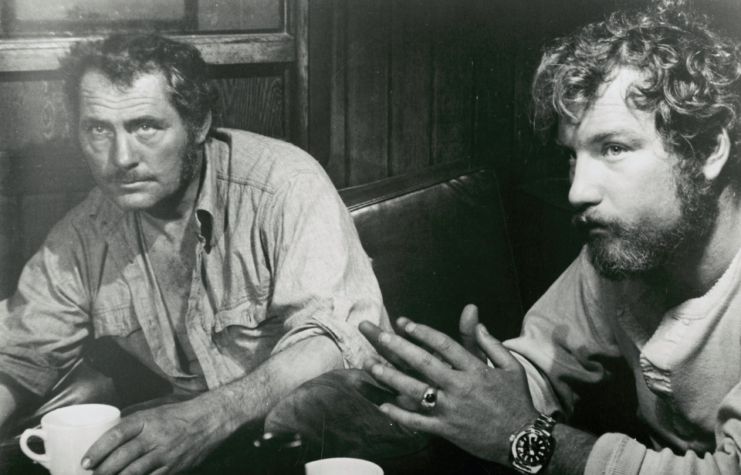The True Story Behind the USS Indianapolis Monologue in ‘Jaws’
Jaws (1975) is a thriller and summertime classic directed by Steven Spielberg and starring Roy Scheider, Richard Dreyfuss and Robert Shaw. The film is based on the 1974 novel by Peter Benchley, which centers around a man-eating great white shark attacking beachgoers on Amity Island, New England. Many are aware that Jaws features one of the most famous monologues in movie history, but did you know it’s based on fact and not fiction?
This is the story behind it.
Quint’s USS Indianapolis (CA-35) monologue in Jaws
Aboard Quint’s (Robert Shaw) boat, he and Hooper (Richard Dreyfuss) compare “battle” scars. Following a chipped tooth from a boxing match and scars from bull and thresher sharks, the conversation turns to Quint’s scar from tattoo removal.
While Hooper jokes that it said, “Mother,” his companion soberly says it related to the USS Indianapolis (CA-35). When Police Chief Martin Brody (Roy Scheider) asks what happened, Quint dictates what’s now become not only the most famous scene in Jaws, but one of cinema’s most famous monologues.
Quint explains that, during the Second World War, a Japanese submarine hit the heavy cruiser with two torpedoes and after 12 minutes the ship sank, leaving the surviving crewmen stranded in shark-infested waters. He says that their mission – to deliver the atomic bomb used over Hiroshima – was so secret that no distress signal was sent out, and they weren’t listed as overdue for a week.
The veteran then goes on to describe the horrifying experience he and other crew members had while waiting in the water:
“Very first light, Chief, sharks come cruisin’, so we formed ourselves into tight groups. It was kinda like old squares in the battle, like you see on a calendar, like the Battle of Waterloo, and the idea was the shark comes to the nearest man, that man he starts poundin’, hollerin’ and screamin’ and sometimes that shark he go away… Sometimes he wouldn’t go away.
“Sometimes that shark he looks right into you. Right into your eyes. You know the thing about a shark is he’s got lifeless eyes. Black eyes. Like a doll’s eyes. When he comes at ya, doesn’t seem to be livin’… Until he bites ya, and those black eyes roll over white and then… Ah then you hear that terrible high-pitched screamin’. The ocean turns red, in spite of all the poundin’ and the hollerin’, they all come in and… They rip you to pieces.”
The monologue explains the character of Quint and why he’s the way he is.
Sinking of the USS Indianapolis (CA-35)

Having served in the Pacific Theater throughout World War II, the USS Indianapolis was sent to Tinian with parts for Little Boy, which was to be dropped over Hiroshima. After completing this task and briefly stopping in Guam, Indianapolis headed for the Philippines.
At a quarter after midnight on July 30, 1945, the Japanese cruiser submarine I-58 fired two Type 95 torpedoes at the US Navy vessel, striking her on the starboard side. Indianapolis sank within 12 minutes, and roughly 300 sailors died aboard the ship.
The remaining 895 crew members were stranded in the water. Just like Quint described, they faced the threat posed by sharks. After four days, the survivors were rescued – but only 316 wound up making it out of the terrifying incident alive.
There are a few issues with the Jaws monologue

The major points in Quint’s monologue hold up. There are, however, a few small issues. For instance, the veteran says 1,100 men went into the water when the actual number was closer to 895. Another is that he says the date of the incident was June 29, 1945, when, in fact, the USS Indianapolis actually sank shortly after midnight on July 30.
A third issue, if you can even call it that, is that many of the men in the water died of dehydration, drowning or exposure. That being said, this is hardly an issue because all those in the water, whether alive or dead, were prey for the sharks.
Besides small issues such as these, which are rather pedantic, everything else, from their mission to the types of aircraft that spotted and rescued the survivors, holds merit; Quint’s monologue is not only an eerie part of Jaws – it’s true.
Who wrote the monologue?

With the content of the monologue being true, the only debate that remains is who on the Jaws team actually wrote it.
For many years, John Milius was given the credit. Steven Spielberg says Milius dictated the speech on the phone, resulting in a 10-page monologue, which Robert Shaw edited. In a featurette about the film’s production, he said, “It’s Milius’ words, and it’s Shaw’s editing.”
Jaws co-screenwriter Carl Gottlieb, however, disagrees. In an interview with The Writer’s Guild Foundation, he stated it was actually Shaw who wrote the speech. Gottlieb said there were originally 10 different versions, including one he himself wrote. These were all given to Shaw, who read them and came up with his version, which was used in the film.
Gottlieb recalled that Shaw “took it all, synthesized it. And one night, while we are all at dinner, he came in with a handful of paper and said, ‘I think I have the pesky speech licked.’ And he basically performed it for the table, and we all went, ‘Wow.’ And Steven said, ‘That’s what we’re shooting.'”
More from us: The True Story Behind the Court-Martial Scene in ‘Band of Brothers’
The movie’s co-screenwriter concluded by saying it was Shaw’s speech and that “because John and Steven are close friends, Steven has always supported Milius’ version, which, in [Gottlieb’s] estimation, is false.”
The post The True Story Behind the USS Indianapolis Monologue in ‘Jaws’ appeared first on warhistoryonline.
The True Story Behind the USS Indianapolis Monologue in ‘Jaws’
Philippines Truth
Post a Comment
0 Comments